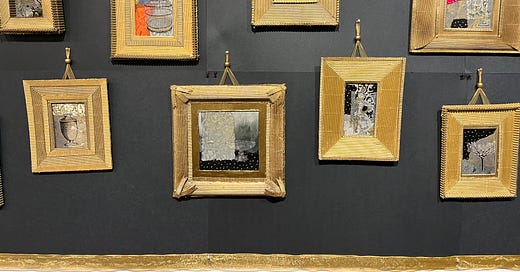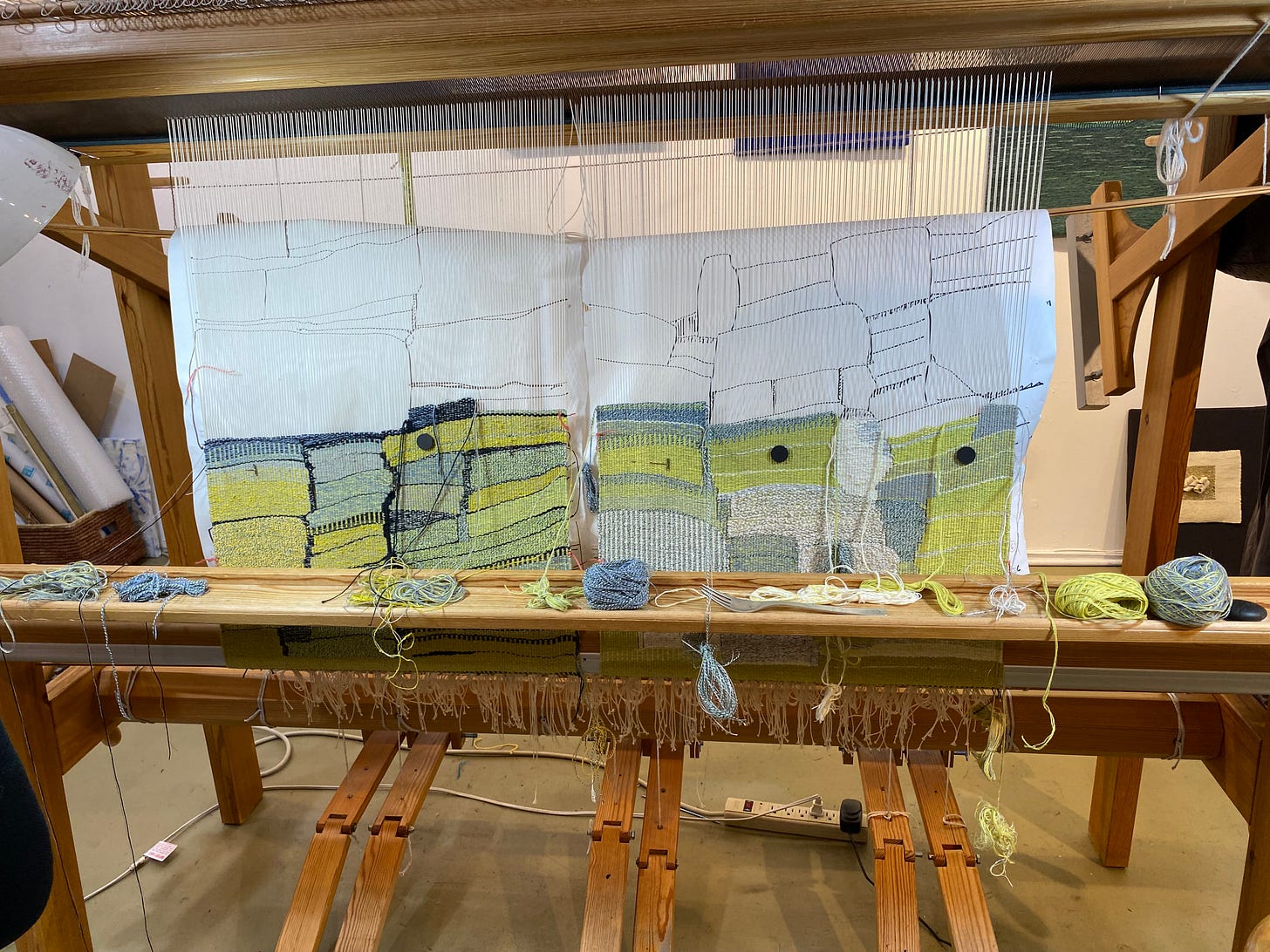Kim Armstrong’s decorative cardboard framed sense of place.
When I was thinking about what to write in this post, I checked into what is frequently at the top of my mind. Here’s what came up:
Bringing together people of all ages, stages, and backgrounds;
I don’t need any new clothes, but love variety and pockets;
I need to lighten up, give away stuff I’ve collected over the years.
As we age, we become aware of the need to let go of earthly possessions.
Transferring Common Objects & Familiar Places into Art
Recently, Bob and I visited the Sausalito ICB artists winter open studios. Three exhibits caught my eye:
Kim Armstrong Artist Statement: I have always had a strong sense of place. My paintings are about creating a visual experience, which provides a place of peace, refuge and thoughtfulness.
Chris Adessa’s “Everyday Sacred.” In her series Everyday Sacred she celebrates the extraordinary in the ordinary, the magnificence of the mundane. She paints portraits of commonplace, enduring objects: a light bulb, a baseball, a paper bag… in a finely nuanced monochrome palette.
Alex Friedman’s Handwoven Tapestry. Her current interest is weaving tapestry that reflects the layers of rock formation over centuries and other evolutions in nature.
Creating Art from Artifacts
All three artists are creating art out of their interests in ordinary ojects/artifacts and/or familiar objects in nature. An artifact is a human-made object, such as a tool, weapon, or work of art, that is of historical or archaeological interest. The word artifact comes from the Latin words arte, meaning "by skill", and factum, meaning "to make.” Source: AI
These three artists create art from artifacts, common objects that lighten their hearts and give meaning to their lives. We share with others through our art and writing.
Aprons as Social Connectors
Aprons are artifacts meaningful to me. Aprons bring together people of all walks of life. The photo above is from the first apron workshop I facilitated as an activity coordinator, in which participants designed their own aprons.
A recent NY Times article about Hannah Neeleman made me think of aprons as cultural connectors. This former ballerina, fashion model and social media star is featured in an article entitled: “Tycoon or Tradwife? The Woman Behind Ballerina Farm Makes Her Own Path.” Welcome to Ballerina Farm, her home. Hannah designs aprons, among her other skills. She is a Morman Christian who lives with her family on a 128-acre farm in Northern Utah. She is married to Daniel Neeleman, the son of the founder of JetBlue Airways. I do not live on a 128-acre farm in Northern Utah and do not have eight children, as do Hannah and Daniel. But I feel a kind of kinship with her. We both love aprons.
The First Apron Wearers
Aprons are IN and have been since between the 6th and 4th century BCE. The first people to wear aprons were MEN.
Rakusu represents the garments that the Buddha put together to wear after he left his palace to seek enlightenment. Monastic scapulars originated as aprons worn by medieval monks, and later became part of the habits for members of religious organizations, orders or confraternities. Source: Wikipedia.
Aprons started out being worn by men to keep their garments clean. Aprons were later worn by popes as decorative adornments. Since medieval times, chefs have worn aprons and large hats to protect themselves from the kitchen’s heat and mess and to show their status. Carpenters, blacksmiths and stone layers wore aprons to stop their clothes from getting ruined. Women have been wearing aprons since the 1300s. Aprons became a fashion statement in the 1500s, continuing to present times. Amazon has over 10,000 results for “aprons!”
Sharing Apron Stories
When I was training to become an activity coordinator in 2009, I facilitated my first apron group in a long-term care community. Community members of all levels of care created their own apron designs. Even those who could not talk, walk or move shared their preferences for color, design, style, and fabric, sometimes by eyes lighting up or nodding. As an educator and practitioner in the eldercare and counseling industries for most of my adulthood, I have presented, at the American Counseling Association and many other conferences, the value of aprons to bring together people of all walks of life
Over the years, I collected aprons and still have one I wore as a child that matched my mother’s apron. As a young adult, I sewed aprons for all the women in my extended family, with matching ties for the men. These days I wear aprons with pockets to the farmers market, rather than carry a handbag, and write about aprons, while others design aprons, make films about aprons (i.e., The Christmas Apron), write adult and children books about aprons (i.e., Eric Carle’s “My Apron”_), create dance and theater performances about aprons (i.e., “Behind the Apron” and “A Broadway Dresser’s Apron”), …the list goes on and on about what one can do with aprons.
Is there an artifact that represents what is meaningful to YOU?
Somthing To Think About
What do you think about frequently?
What are you doing now or could you do to bring folks together, who may have different backgrounds and values?
Share a story or create an art project about what you do or could do to bring folks together.
More fashion articles:










